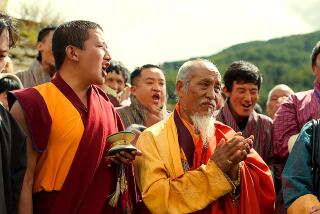Inside Myanmar uprising
- Share via
Danish filmmaker Anders Ostergaard was in Myanmar to do a half-hour portrait on a young member of the Democratic Voice of Burma, an underground group of video journalists determined to document the oppressive conditions in the country, when suddenly, in September 2007, the Buddhist monks’ rebellion broke out. It had been sparked by the military government’s decision to lift fuel subsidies, causing some fuel prices to jump as much as 500% overnight.
“Burma VJ” -- for video journalist -- is filmmaking at its most fearless, with Ostergaard creating a suspenseful, harrowing account of his original key subject, known only as “Joshua,” whose face is never seen, and his colleagues risking their lives to record the “Saffron Rebellion” and its dire consequences in order that the whole world could see for itself a brave attempt to challenge one of the most brutal and repressive military dictatorships on the planet. (DVB was able to transmit its images via satellite to Oslo; one of the strongest is that of the bloody corpse of a monk floating face-down in a creek.)
The public, with large numbers of students, began joining the monks in their demonstrations. Yet history repeated itself: As with the 1988 uprising that the military forcefully crushed, this rebellion too was put down with the utmost brutality. While several of his colleagues were caught and face life imprisonment, Joshua survived to continue to dedicate his life to showing what’s really going on in his country.
--
Kevin Thomas --
“Burma VJ.” MPAA rating: Unrated. Running time: 1 hour, 10 minutes. At the Sunset 5 in West Hollywood.
--
Ambitious teen setting rings false
You can fault the alienating anti-comedy “What Goes Up” for many things, but you can’t accuse it of lacking ambition. In just under two hours, writer-director Jonathan Glatzer sandwiches in an entire season of after-school specials, ruminating on suicide, unplanned pregnancy, sexual abuse, abortion, the perils of public masturbation, the nature of American heroism and the Challenger space shuttle tragedy.
Dyslexia and eradicating world famine will have to wait for another movie, I guess.
If Glatzer, who co-wrote the film with Robert Lawson, had committed to a tone, the movie’s pretensions might have been easier to suffer. As it is, “What Goes Up” teeters between pale, Mike White-style black humor and self-seriousness, while using the impending Challenger explosion to brazenly boost the tension.
Steve Coogan plays Campbell Babbitt, a dissolute New York journalist who is known for his way around an inspirational tale -- whether or not it’s true. On the eve of the Challenger launch, Babbitt goes to New Hampshire to profile Christa McAuliffe, the local high school teacher joining the astronauts.
Upon arriving, Babbitt immediately winds up in the middle of a group of misfit teens mourning the suicide of an inspirational teacher. Babbitt went to college with the teacher, and the students grab this loose connection like a lifeline.
Glatzer aims to wring laughter out of this desperation but succeeds only in producing a series of contrived characters and situations that make “The Breakfast Club” look like an unfiltered documentary.
That the filmmakers appear to have never set foot on a high school campus (and don’t even get me started on the newsroom stuff) serves to make their characters’ pain our own, just not in the way intended.
--
Glenn Whipp --
“What Goes Up.” MPAA rating: R for sexuality, language and some drug use, all involving teens. Running time: 1 hour, 47 minutes. In selected theaters.
More to Read
Only good movies
Get the Indie Focus newsletter, Mark Olsen's weekly guide to the world of cinema.
You may occasionally receive promotional content from the Los Angeles Times.










